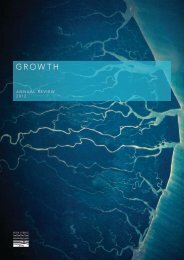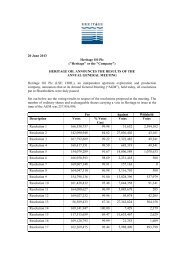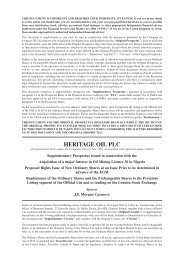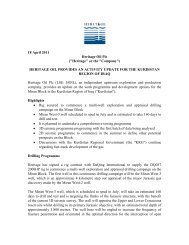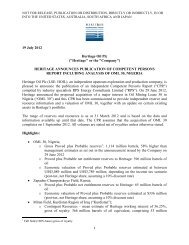Prospectus re Admission to the Official List - Heritage Oil
Prospectus re Admission to the Official List - Heritage Oil
Prospectus re Admission to the Official List - Heritage Oil
Create successful ePaper yourself
Turn your PDF publications into a flip-book with our unique Google optimized e-Paper software.
RPS Energy<strong>Heritage</strong> <strong>Oil</strong> – Competent Persons ReportA summary of input rock and fluid properties is given in Table 12.Low Mid HighMishrif/MauddudGRV ............................................. MM m 3 1,671 3,844 4,023N:G.............................................. % 1 1 1Porosity-Mish-Maudd ................................. % 1.3 1.7 2.1Porosity- Mish 2&3 ................................... % 1.7 2.85 4.0Sw............................................... % 50 33 18.51/FVF ............................................ stb/rb 0.392 0.370 0.351ThamamaGRV ............................................. MM m 3 559 1,091 1,622N:G.............................................. 1 1 1Porosity ........................................... % 1.6 2.3 3.0Sw............................................... % 50 40 301/FVF ............................................ stb/rb 0.488 0.455 0.426Table 12:West Bukha Volumetric Input ParametersIn-place volumes we<strong>re</strong> calculated probabilistically for <strong>the</strong> Mishrif/Mauddud and Thamama <strong>re</strong>servoirs forboth <strong>the</strong> whole field and for <strong>the</strong> portion of <strong>the</strong> field in Omani waters.Whole Field (MMstb) Omani Waters (MMstb)Reservoir p90 p50 p10 p90 p50 p10Mishrif/Mauddud ............................. 168.0 242.0 331.0 53.6 82.9 119.0Thamama ................................... 54.5 88.5 136 24.8 41.2 62.7Total ................................... 252.0 335.0 434.0 91.2 126.0 267.0N.B.The <strong>to</strong>tals a<strong>re</strong> <strong>the</strong> p90, p50 and p10 of <strong>the</strong> s<strong>to</strong>chastically consolidated distributions.Table 13:West Bukha In place Volumes 100 per cent. Basis3.3.4. Petroleum Engineering3.3.4.1. Reservoir Fluid PropertiesThe<strong>re</strong> has p<strong>re</strong>viously been debate amongst <strong>the</strong> legacy owners of <strong>the</strong> West Bukha field as <strong>to</strong> whe<strong>the</strong>r <strong>the</strong><strong>re</strong>servoir contains a rich gas (or ‘‘condensate’’) type fluid, or a volatile oil, and latterly <strong>the</strong> field ownershave come <strong>to</strong> <strong>the</strong> conclusion that <strong>the</strong> <strong>re</strong>servoir fluid is a volatile oil. Such confusion is common when <strong>the</strong>fluid is a near-critical point fluid, as liquid:gas ratios during short well tests can be misleading, and<strong>re</strong>p<strong>re</strong>sentative sampling difficult. We note that <strong>the</strong> NIOC has always maintained that <strong>the</strong> field is a volatileoil field.Upon examination of <strong>the</strong> fluid samples captu<strong>re</strong>d in wells Henjam-1 and West Bukha-2, and <strong>the</strong> labora<strong>to</strong>ryanalyses of same, we have concluded that <strong>the</strong> fluid is mo<strong>re</strong> likely <strong>to</strong> be oil at <strong>re</strong>servoir conditions, for <strong>the</strong>following <strong>re</strong>asons:The methane (‘‘C 1 ’’) content is below 60mol per cent.;The test separa<strong>to</strong>r GOR is 12 mol per cent.;The CVD experiment yielded 100 per cent. liquid saturation at <strong>the</strong> saturation p<strong>re</strong>ssu<strong>re</strong>;A diffe<strong>re</strong>ntial vaporisation experiment was performed and a bubble point measu<strong>re</strong>d (this would not bepossible on a gaseous fluid).The initial <strong>re</strong>servoir fluid composition is as shown in Table 3.6 overleaf. The source of this is <strong>the</strong> PVTanalysis of samples from DST 2 in <strong>the</strong> Mishrif Formation in Well West Bukha-2; <strong>the</strong> <strong>re</strong>servoir fluid in <strong>the</strong>underlying Thamama formation is similar. Approximately 1.4 mol per cent. H 2 S has been measu<strong>re</strong>d in <strong>the</strong><strong>re</strong>servoir samples, and approximately 14 mol per cent. CO 2 and N 2 .87



